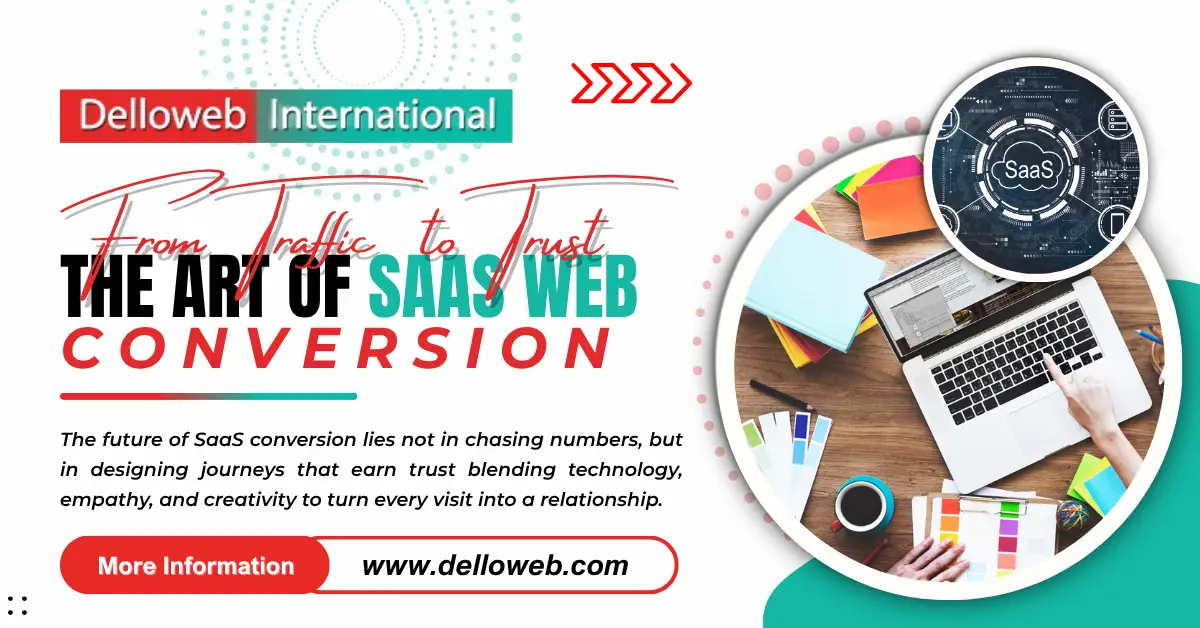
Introduction
In today’s competitive digital landscape, having a visually appealing SaaS website isn’t enough — it needs to convert visitors into loyal customers. Whether you’re launching a new product or improving an existing platform, following SaaS Website Best Practices is essential for growth.
At Delloweb, we specialize in creating high-performing software landing pages and conversion-driven designs that not only attract attention but also generate measurable results. Let’s explore the proven strategies and SaaS UX tips that will help your website convert more effectively.
Why SaaS Website Optimization Matters
A well-optimized SaaS website is your strongest sales tool. It:
- Builds trust with potential customers
- Clearly communicates your product’s value
- Streamlines the user journey from interest to subscription
- Reduces bounce rates and increases free trial sign-ups
By implementing SaaS conversion design principles, you ensure that every click and scroll leads visitors closer to conversion.
1. Clear and Compelling Value Proposition
Your homepage should instantly answer: “What does your software do, and how does it help me?”
Best Practices:
- Use concise, benefit-focused headlines.
- Include a short supporting paragraph explaining your core offering.
- Highlight results or pain points solved by your software.
- Add a strong Call To Action (CTA) like “Start Free Trial” or “Book a Demo.”
Example:
“Boost your team’s productivity with real-time collaboration software that keeps everyone on track.”
This clarity sets the tone for an effective SaaS conversion design.
2. Create High-Impact Software Landing Pages
Dedicated software landing pages for each product or feature are critical for conversions.
Best Practices for SaaS Landing Pages:
- Focus on a single goal (sign-up, demo, or download).
- Remove unnecessary distractions such as extra navigation links.
- Use persuasive visuals or explainer videos.
- Showcase customer testimonials or case studies.
A landing page built on SaaS Website Best Practices ensures every visitor sees value immediately.
3. Optimize SaaS UX for Simplicity
SaaS UX tips emphasize usability and clarity. A simple, intuitive experience helps users understand and trust your product faster.
Key UX Tips:
- Keep navigation straightforward — avoid clutter.
- Use visual hierarchy (contrast, spacing, color) to guide attention.
- Include onboarding elements like tooltips or walkthroughs.
- Ensure forms are short and easy to complete.
Remember: A smooth SaaS user experience directly impacts conversions.
4. Design for Conversion
Conversion-focused design is more than just aesthetics — it’s psychology and structure working together.
Core SaaS Conversion Design Elements:
- Eye-catching CTAs: Use bold, action-driven text.
- Trust Signals: Include logos of clients, certifications, or awards.
- Social Proof: Display customer reviews and testimonials.
- A/B Testing: Experiment with colors, copy, and layout to improve engagement.
When you apply SaaS Website Best Practices, your design naturally drives action.
5. Prioritize Mobile Responsiveness and Speed
More than 60% of SaaS users explore products via mobile devices. A slow or unresponsive site can kill conversions instantly.
Best Practices:
- Optimize images and scripts for faster load times.
- Ensure CTAs are easily clickable on mobile.
- Use responsive design frameworks.
- Regularly test performance using tools like Google PageSpeed Insights.
A fast, mobile-friendly website reflects your brand’s professionalism and boosts credibility.
6. Build Trust Through Transparent Pricing
Visitors want clarity, not confusion. Transparent pricing is a powerful SaaS conversion design element.
Tips for Pricing Pages:
- Clearly show plan differences.
- Include feature comparisons.
- Offer a free trial or money-back guarantee.
- Use consistent and trustworthy design elements.
Transparency builds confidence — one of the cornerstones of SaaS Website Best Practices.
7. Continuous Optimization and Data Analysis
Your SaaS website is never “done.” Continual improvements keep your conversion rate healthy.
Monitor and Improve:
- Use analytics tools to track user behavior.
- Identify drop-off points in the conversion funnel.
- Gather feedback through surveys or chatbots.
- Implement changes and measure impact regularly.
Data-driven SaaS UX tips ensure you evolve alongside user expectations.
Conclusion
Building a high-converting SaaS website requires strategic design, clarity, and continuous refinement. By following SaaS Website Best Practices, your business can attract, engage, and retain users more effectively.
At Delloweb, we help SaaS companies design intelligent, conversion-optimized platforms that drive growth and customer loyalty. Whether it’s developing software landing pages or refining your SaaS UX design, our experts are ready to help.
🚀 Call To Action
Ready to transform your SaaS website into a conversion powerhouse?
👉 Contact Delloweb today for a free consultation and discover how our tailored solutions can boost your online performance.
FAQs
1. What are SaaS Website Best Practices?
They are proven design and content strategies that help SaaS websites maximize conversions, enhance user experience, and communicate product value clearly.
2. How can SaaS conversion design improve my sales?
By optimizing layout, CTAs, visuals, and content flow, SaaS conversion design guides visitors toward taking desired actions such as sign-ups or purchases.
3. Why are software landing pages important?
They focus on one specific goal, minimizing distractions and increasing conversion rates. Each landing page can target a different audience or product feature.
4. What are some essential SaaS UX tips?
Simplify navigation, prioritize readability, use clear CTAs, and make the experience intuitive from sign-up to usage.
5. How often should I update my SaaS website?
Continuously. Regular updates based on analytics and user feedback help maintain a strong conversion rate and a modern, competitive presence.

